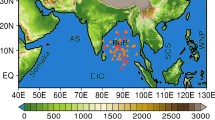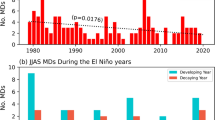Abstract
The paper presents atmospheric coupling physics through identifying a few significant features imprinted on the ionosphere by certain unique seismic environments when a number of successive cluster of earthquakes ranging from 7.1 to 8.2 magnitudes occurred within about two weeks period, over the East-West Pacific zone covering 150° E to 70° W. Amongst the cases considered here are earthquakes of Chile Apr. 1, 2014 (M = 8.2) and Apr. 3, 2014 (M = 7.7), New Guinea Apr. 11, 2014 (M = 7.1) and Solomon Islands 13.04.2014 (M = 7.6). The main data source for the study is Global TEC with supplementary inputs from GPS observations taken at Guwahati (26° N, 92° E), an Appleton anomaly crest region. A few EQ events with epicenters in and around this anomaly zone are also taken in the study to focus on the seismic induced density features like Earthquake time Equatorial Anomaly (EEA) and Earthquake time Equatorial Anomaly Crest (EEAC) developed over the belt. Such anomalous modifications in TEC resulting to growths of EEA and EEAC covering Solomon Islands—New Guinea extending up to Chile along the fault lines for more than a month, are significant observations brought out in the paper. The GPS TEC data from Gauhati University are utilized in identifying the epicentre position through anomalous appearance of satellites beyond the Line Of Sight (LOS) observation. Finally, the seasonal role on enhancing the seismic induced E-field coupled by mutual interactive EQ preparatory effects of the three major events as well as in enhancement of EQ time radon emission through fault is invoked in explanation to the anomalous density features.














Similar content being viewed by others
REFERENCES
Agbo, G.A., Onugwu, A.C., and Ibanga, E.A., Study of equatorial electrojet using chain of stations along the Dip equator, Global J. Sci. Frontier Res., 2017, vol. 17, no. 3-A.
Anderson, D., Anghel, A., Yumoto, K., et al., Estimating daytime vertical ExB drift velocities in the equatorial F–region using ground-based magnetometer observations, Geophys. Res. Lett., 2002, vol. 29, no. 12, pp. 37-1–37-4. https://doi.org/10.1029/2001GL014562
Bondur, V.G. and Smirnov, V.M. Method for monitoring seismically hazardous territories by ionospheric variations recorded by satellite navigation systems, Dokl. Earth Sci., 2005, vol. 403, no. 5, pp. 736−740.
Depueva, A., Peculiarities of low-latitude and equatorial ionosphere prior to strong earthquakes, Geomatics Nat. Hazards Risk, 2012, vol. 3, no. 3, pp. 207–224. https://doi.org/10.1080/19475705.2011.619206
Depueva, A. and Rotanova, N., Low-latitude ionospheric disturbances associated with earthquakes, Ann. Geophys., 2001, vol. 44, no. 2, pp. 221–228. https://doi.org/10.4401/ag-3592
Depueva, A.Kh. and Ruzhin, Yu.Ya., Seismoionospheric fountain-effect as analogue of active space experiment, Adv. Space Res., 1995, vol. 15, no. 12, pp. 151–154. https://doi.org/10.1016/0273-1177(95)00036-E
Depueva, A.Kh., Mikhailov, A.V., Devi, M., and Barbara, A.K., Spatial and time variations in critical frequencies of the ionospheric F region above the zone of equatorial earthquake preparation, Geomagn. Aeron. (Engl. Transl.), 2007, vol. 47, no. 1, pp. 129–133. https://doi.org/10.1134/S0016793207010197
Devi, M. and Barbara, A.K., Total Electron Content and anomalous appearance of GPS satellites as pointers to epicentre identification of major Japan earthquake of 2011, Positioning, 2012, vol. 3, no. 1, pp. 7–12. https://doi.org/10.4236/pos.2012.31002
Devi, M., Barman, M.K., Barbara, A.K., and Depueva, A.H., Ionospheric electron content near anomaly crest as precursor of earthquake, Indian J. Radio Space Phys., 2001, vol. 30, no. 4, pp. 209–213.
Devi, M., Barbara, A.K., and Depueva, A., Association of Total Electron Content (TEC) and foF2 variations with earthquake events at the anomaly crest region, Ann. Geophys., 2004, vol. 47, no. 1, pp. 83–91. https://doi.org/10.4401/ag-3261
Devi, M., Barbara, A.K., Ruzhin, Yu.Ya., and Depueva, A.H., Beyond the horizon propagation of VHF signals: Atmospheric features and earthquake beyond the horizon propagation of VHF signals, atmospheric features and earthquake, Investigated in Russia, 2007, vol. 129e, pp. 1331–1340.
Devi, M., Barbara, A.K., Depueva, A.H., et al., Anomalous total electron content (TEC) and atmospheric refractivity prior to the very strong China earthquake of May 2008, Int. J. Remote Sens., 2010, vol. 31, no. 13, pp. 3589–3599. https://doi.org/10.1080/01431161003727663
Devi, M., Barbara, A.K., Kashyp, P., et al., Earthquake time low latitude TEC and model estimated values: Identification on earthquake induced atmospheric dynamics, Advances in Geosciences, Satake, K. and Duldig, D., Eds., Singapore: World Scientific, 2011, vol. 27, pp. 69–84. https://doi.org/10.1142/9789814355414_0008
Devi, M., Medhi, A., Sarma, A.J., and Barbara, A.K., Growth and inhibition of equatorial anomaly prior to an earthquake (EQ): Case studies with Total Electron Content (TEC) data for major EQs of Japan 2011 and Indonesia 2012, Positioning, 2013, vol. 4, no. 3, pp. 240–252. https://doi.org/10.4236/pos.2013.43024
Devi, M., Medhi, A., Barbara, A.K., et al., Orographic role in anomalous VHF propagation on the background of impending earthquakes, Ann. Geophys., 2015a, vol. 58, no. 3, A0333. https://doi.org/10.4401/ag-6716
Devi, M., Barbara, A.K., Oyama, K.-I., et al., Expansion of earthquake (EQ) time equatorial anomaly: An index of precursor as seen in major Nepal EQ of April 2015, Int. J. Electron. Appl. Res., 2015b, vol. 2, no. 2, pp. 46–59. http://www.eses.net.in/journal.html.
Devi, M., Patgiri, S., Barbara, A.K., et al., Role of equatorial anomaly in earthquake time precursive features: A few strong events over West Pacific zone, Adv. Space Res., 2018, vol. 61, no. 6, pp. 1444–1455. https://doi.org/10.1016/j.asr.2018.01.003
Fan, Y. and Du, X., An, Z., et al. Earthquake-related electric field changes observed in the ionosphere and ground, Acta Geophys., 2015, vol. 63, no. 3, pp. 679–697. https://doi.org/10.1515/acgeo-2015-0015
Freund, F., Stress-activated positive hole charge carriers in rocks and the generation of pre-earthquake signals; Electromagnetic Phenomena Associated with Earthquakes, Hayakawa, M., Ed., Trivandrum, India: Transworld Research Network, 2009, pp. 41–96.
Gokhberg, M.B., Morgounov, V.A., Yoshino, T., and Tomizawa, I., Experimental measurement of electromagnetic emissions possibly related to earthquakes in Japan, J. Geophys. Res., 1982, vol. 87, no. B9, pp. 7824–7828. https://doi.org/10.1029/JB087iB09p07824
Hayakawa, M. and Fujinawa, Y., Electromagnetic Phenomena related to Earthquake Prediction, Tokyo: Terra Scientific, 1994.
Hayakawa, M. and Hobara, Y., Current status of seismo-electromagnetics for short-term earthquake prediction, Geomatics Nat. Hazards Risk, 2010, vol. 1, no. 2, pp. 115–155. https://doi.org/10.1080/19475705.2010.486933
Kinkela, S.M., Estimating equatorial F-region daytime vertical ExB drift velocities from ground-based magnetometer measurements in the Philippine longitude sector, Ph.D. Thesis, Air Force Institute of Technology, 2004, AFIT/GAP/ENP/04-04.
Li, M. and Parrot, M., Statistical analysis of an ionospheric parameter as a base for earthquake prediction, J. Geophys. Res., 2013, vol. 118, no. A6, pp. 3731–3739. https://doi.org/10.1002/jgra.50313
Liu, J.-Y., Chen, C.-H., Lin, C.-H., et al., Ionospheric disturbances triggered by the 11 March 2011 M9.0 Tohoku earthquake, J. Geophys. Res., 2011, vol. 116, no. A6, A06319. https://doi.org/10.1029/2011JA016761
Molchanov, O.A. and Hayakawa, M., Seismo-Electromagnetics and Related Phenomena: History and Latest Results, Tokyo: Terrapub, 2008.
Muir-Wood, R. and King, G.C.P., Hydrological signatures of earthquake strain, J. Geophys. Res., 1993, vol. 98, no. B12, pp. https://doi.org/10.1029/93JB02219
Oyama, K.-I., Devi, M., Ryu, K., et al., Modifications of the ionosphere prior to large earthquakes: Report from the Ionosphere Precursor Study Group, Geosci. Lett., 2016a, vol. 3, no. 6, https://doi.org/10.1186/s40562-016-0038-3
Oyama, K.I., Liu, H., Devi, M., et al., Statistical study on ionosphere disturbance before large earthquake: Report on Ionospheric Precursor Study Task Group, Mitsubishi Foundation, 2016b, pp. 1–104, id 26113.
Ruzhin, Yu. and Nomicos, C., Radio VHF precursors of earthquakes, Nat. Hazards, 2007, vol. 40, pp. 573–583. https://doi.org/10.1007/s11069-006-9021-1
Ryu, K., Oyama, K.-I., Bankov, L., et al., Precursory enhancement of EIA in the morning sector: Contribution from mid-latitude large earthquakes in the north-east Asian region, Adv. Space Res., 2016, vol. 57, no. 1, pp. 268–280. https://doi.org/10.1016/j.asr.2015.08.030
Smirnov, V.M., Bondur, V.G., and Smirnova, E.V., Ionospheric disturbances during of the tsunamigenic earthquake on navigation system data, Asian Association on Remote Sensing, 26th Asian Conference on Remote Sensing and 2nd Asian Space Conference (ACRS), 2005, vol. 3, pp. 1487–1494.
Smirnov, V.M., Smirnova, E.V., Tsidilina, M.V., and Gaponova, M.N., Seismo-ionospheric variations during strong earthquakes based on the example of the 2010 earthquake in Chile, Cosmic Res., 2018, vol. 56, no. 4, pp. 310–318. https://doi.org/10.1134/S0010952518040068
Sorokin, V.M., Ruzhin, Y.Y., Yaschenko, A.K., and Hayakawa, M., Generation of VHF radio emissions by electric discharges in the lower atmosphere over a seismic region, J. Atmos. Sol.-Terr. Phys., 2011, vol. 73, nos. 5–6, pp. 664–670. https://doi.org/10.1016/j.jastp.2011.01.016
Voinov, V.V., Gufeld, I.L., Kruglikov, V.V., et al., Effects in the ionosphere and atmosphere before the Spitak earthquake on 7 December 1988, Fiz. Zemli, 1992, no. 3. pp. 96–101.
Yonaiguchi, N., Ida, Y., and Hayakawa, M., On the statistical correlation of over-horizon VHF signals with meteorological radio ducting and seismicity, J. Atmos. Sol.-Terr. Phys., 2007, vol. 69, no. 6, pp. 661–674. https://doi.org/10.1016/j.jastp.2007.01.007
ACKNOWLEDGMENTS
The authors M. Devi, A.K. Barbara, A. Depueva, V. Depuev, and Yu. Ruzhin acknowledge with thanks the financial support received from the DST, India and RFBR, Russia through Grant no. 17-55-45 094 a_IND., for conducting this work under the project “Lower atmospheric forcing leading to modifications in the upper atmosphere“. Further, M. Devi and K.-I. Oyama express their deep acknowledgment to the Mitsubishi Foundation for providing research Fund (ID: 26113) in carrying out part of the work of the paper.
Author information
Authors and Affiliations
Corresponding author
Ethics declarations
The authors declare that they have no conflict of interest.
Rights and permissions
About this article
Cite this article
Devi, M., Barbara, A.K., Patgiri, S. et al. Perturbation Features Imprinted on Ionosphere by Successive Clusters of Strong Earthquakes: Role of Atmospheric Coupling Dynamics. Geomagn. Aeron. 59, 955–970 (2019). https://doi.org/10.1134/S0016793219080036
Received:
Revised:
Accepted:
Published:
Issue Date:
DOI: https://doi.org/10.1134/S0016793219080036




